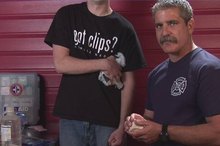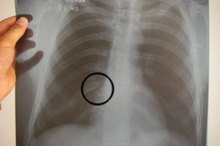Rehab for a Broken Rib
A broken rib can be a frustrating injury, because there just isn’t a lot that you can do for it to help it heal more quickly. However, there are a few ways to help ease the pain of a rib fracture, prevent further complications and get back to normal activity.
How is A Broken Rib Treated?
Broken ribs usually occur from trauma to the chest, such as from a fall, motor vehicle accident or impact during contact sports. Most people who suffer a broken rib actually have a cracked rib, according to the Mayo Clinic. Cracked ribs aren't as potentially dangerous as ribs that have been broken, since a jagged piece of bone could damage major blood vessels or internal organs.
Unlike an arm or leg break, a broken rib isn’t set in a cast. Instead, the ribs are left to heal on their own, and can take up to six weeks in the case of fracture, and 12 weeks or more if the rib has been torn from the cartilage, according to the Better Health Channel. In the past, doctors would wrap the injured area to help splint and immobilize the area, but are no longer used because they can keep you from taking deep breaths, which can increase the risk of pneumonia.
- Broken ribs usually occur from trauma to the chest, such as from a fall, motor vehicle accident or impact during contact sports.
- Instead, the ribs are left to heal on their own, and can take up to six weeks in the case of fracture, and 12 weeks or more if the rib has been torn from the cartilage, according to the Better Health Channel.
Pain Medication
How to Tape Cracked Ribs
Learn More
Doctors typically prescribe over-the-counter pain medication such as acetaminophen or ibuprofen. If the pain is severe, a doctor may prescribe stronger pain medication or suggest injections of long-lasting anesthesia around the nerves that supply the ribs. While you may not want to take pills, it's important to obtain adequate pain relief because if it hurts too much to breathe deeply, you may develop pneumonia, according to the Mayo Clinic.
Rest, Ice and Avoiding Further Trauma
Rehabilitating a broken rib starts with getting adequate rest and avoiding sports and activities which increases pain in the area, according to Physio Adviser.com. Depending on your job and the severity of the injury, you may need time off work. The use of ice packs may help to reduce inflammation in the early stages of the injury. The area should not be wrapped or otherwise compressed, and deep breathing exercises are encouraged to prevent localized collapse of the lungs.
- Rehabilitating a broken rib starts with getting adequate rest and avoiding sports and activities which increases pain in the area, according to Physio Adviser.com.
- The use of ice packs may help to reduce inflammation in the early stages of the injury.
As Your Condition Improves
Ribs Cracking and Stretching
Learn More
Once you are pain-free, you may gradually return to sports and other activities that were aggravating the broken rib. Additionally, you may perform shoulder blade squeezes, as described by Physio Adviser.com. Squeeze your shoulder blades together as far as possible without pain. Hold for 1 to 2 seconds and repeat 10 times, provided there is no increase in symptoms.
- Once you are pain-free, you may gradually return to sports and other activities that were aggravating the broken rib.
Related Articles
References
- Patient.co.uk; Care of Rib Injuries
- May L, Hillerma C, Patil S. Rib fracture management. BJA Education. 2016;16:1. doi:10.1093/bjaceaccp/mkv011
- Talbot BS, Gange CP, Chaturvedi A, Klionsky N, Hobbs SK, Chaturvedi A. Traumatic Rib Injury: Patterns, Imaging Pitfalls, Complications, and Treatment. Radiographics. 2017;37(2):628-651. doi:10.1148/rg.2017160100
- Quick G. A randomized clinical trial of rib belts for simple fractures. Am J Emerg Med. 1990;8(4):277-81. doi:10.1016/0735-6757(90)90073-9
- Quick, G. "A randomized clinical trial of rib belts for simple fractures." Am J Emerg Med. Jul 1990.
- Sirmali, M, et al."A comprehensive analysis of traumatic rib fractures: morbidity, mortality, and management." Eur J Cardiothorac Surg. Jul 2003.
Writer Bio
A resident of Edgewood, Ky., Gabrielle Dion has been writing professionally since 1997. In college, she served as editor-in-chief of her campus newspaper, "The Northerner." Dion has worked as a freelance writer for the "Cincinnati Enquirer" and blogged for Cincinnati.com, where she chronicled her first marathon-training experience. She holds a Bachelor of Arts in journalism from Northern Kentucky University.








